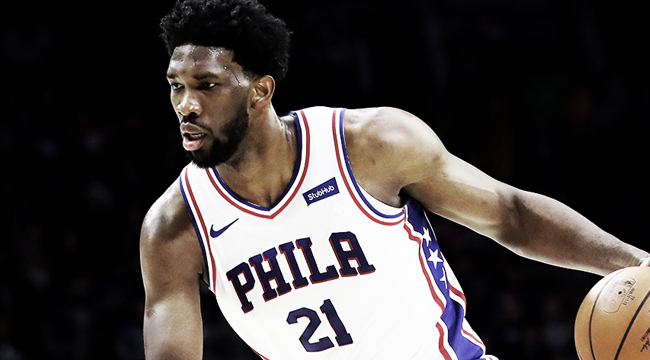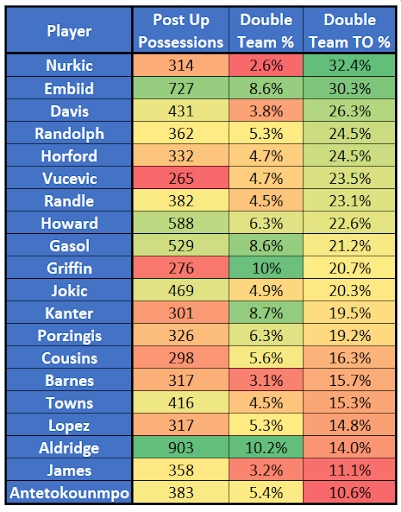
Joel Embiid is clowning fools this preseason. He is averaging 33.8 points per-36 minutes and shooting an otherworldly 70.2 percent (33-for-47) from two-point range.
But for the Sixers’ star big man, the number 5.9 looms over his head, and despite his otherwise remarkable play, it’s the single-largest number holding him back from entering the stratosphere of the NBA’s top-tier.
That number, 5.9, represents Embiid’s turnovers per-36 minutes, topping the 5.4 turnovers per 36 he averaged in his rookie campaign. Nine big men averaged at least two turnovers per game last year: Embiid, DeMarcus Cousins, Blake Griffin, Nikola Jokic, Marc Gasol, Dwight Howard, Andre Drummond, Jusuf Nurkic and Anthony Davis.
Among that group, only Anthony Davis committed a higher proportion of “Lost Ball” turnovers than Embiid.

In addition, Embiid was unique in his play type usage. He led the group in post up usage, finishing 44 percent of his plays on the block (Embiid ranked second in the NBA is post ups per game, trailing only LaMarcus Aldridge). He and Cousins were the only two members of the group who devoted the lion’s share of their possessions to post ups and spot ups.

Despite 101 of Embiid’s turnovers coming on post ups, his 13.9 percent turnover rate on these plays ranked only third highest among the group. While Embiid did not turn the ball over on fewer than eight percent of his possessions in any of his most frequent play types, his post ups accounted for the highest proportion of his overall turnovers.
Of the NBA’s top-20 players in post touches, Embiid’s turnover percentage ranked a modest fifth — Howard led at 16.2 percent. But delving further into the numbers begins to paint a more complete picture.
Embiid faced a double team on 8.6 percent of his post ups, trailing only Aldridge (10.2 percent) and Griffin (10 percent) in that group. Yet in those situations, Embiid turned the ball over an astounding 30.3 percent of the time, trailing only Nurkic, who saw double teams just 2.6 percent of the time.

Embiid is one of the most deliberate post players in the NBA. He averaged 2.19 seconds per touch despite dribbling just 0.9 times per touch. He turned and faced the basket on a league-leading 54 percent of his possession-ending post ups last season and was efficient doing so, scoring 1.07 points per possession.
But his deliberate nature can function as a double-edged sword. In the clip below, Embiid holds the ball for a full seven seconds before Sam Dekker commits to the turnover-inducing double team.
This is, of course, not to say that Embiid cannot make quick decisions out of the post. Watch here as he finds a cutting Ben Simmons for an easy layup after turning to scan the defense.
In fact, the Sixers scored 1.23 points per possession following an Embiid pass out of the post, which ranked in the 70th percentile. The issue is the frequency with which that occurs. Embiid only passed out of the post an astounding 18.4 percent of the time, third-worst among the top-20 most-used post players.
Sometimes, it didn’t matter, as there were times in which he was simply too skilled even for the best-designed defenses.
But often, his late reaction to the coming double team led to reckless turnovers and easy buckets the other way.
When faced with a double team, Embiid passed only 48.6 percent of the time. Only Nurkic (41.2 percent of the time) passed less frequently … but Embiid saw a double team nearly four times more often. As in the above clip — where Embiid had Dario Saric wide open at the top of the arc — his desire to methodically assess the defense can prevent him from making decisions that jump-start the offense.
When Kyle Korver stunts to the ball, watch how Embiid’s decision to take an initial dribble actually cuts off his passing angle to J.J. Redick, transforming an open three pointer into a turnover.
Other times, Embiid opts for the most difficult of all potential passes. Here, he has an easy outlet pass to Redick, one of the best shooters on the planet. (Note that Simmons is pointing at Redick while setting the flare screen to free him). Instead, Embiid opts to thread a difficult cross-court heave to Ersan Ilyasova. The pass finds its mark, but puts Ilyasova in an undesirable situation that ultimately results in a turnover.
There is no debating that Embiid is one of the most feared post players in the entire NBA. His combination of size and skill allows him to draw at least two sets of eyes every time he touches it on the block.
After scoring 0.97 points per post up last year, eighth among players with at least 150 post possessions, he has scored 1.03 points per post up on 37 possessions this preseason. Additionally, his jump from shooting 50 percent to 64 percent in the action should create even better results.
The only thing holding him back? A 27 percent turnover rate, which is double his rate from last year.
The attention Embiid draws should make his improvement in this area vast once things click. Watch last year as he makes an outlet pass out of the double team to Robert Covington.
Simple enough, right? The Sixers ping the ball around the perimeter and find Redick for an open three.
Last season, Embiid turned the ball over on 15.8 percent of his total possessions, which ranked in the 28th percentile for all big men. His turnovers played a large role in why the Sixers ranked dead last in turnover rate (16.5 percent). Philadelphia was one of only two top-10 offenses, Cleveland being the other, that finished ranked higher in effective field goal percentage (fifth) than offensive rating (ninth). Cutting down on turnovers will go a long way towards making Philadelphia one of the most potent offenses in the league and a legitimate challenger for the Eastern Conference crown.
To do so, Embiid does not need to become a LeBron James-level passer to open up easy scoring opportunities for his teammates. Instead, he must simply read the defense and react quickly. This does not mean making the heroic play, but rather making the right play to keep the ball moving. In the process, he will create better looks for himself by drawing more one-on-one opportunities.
And of course, when he gets those opportunities, he can keep doing what he does as well as any other big man in the league: clown fools.






